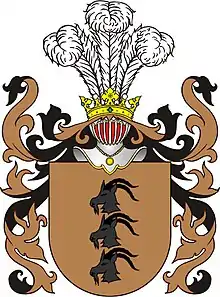| Zerwikaptur | |
|---|---|
 | |
| Details | |
| Battle cry | - |
| Alternative names | Koziegłowy |
| Earliest mention | Unknown |
| Towns | None |
| Families | Bionetowski, Cieszkiewicz, Cieszkowski, Dobrogwil, Kozieglowski, Minolganski, Pasiowski, Podbipieta, Pollupieta, Zbigwicz, Zerwikaptur, |
Zerwikaptur is a Polish coat of arms. It was used by several gentry families in the times of the Polish–Lithuanian Commonwealth.

Zerwikaptur coat of arms in Baranow-Sandomierski castle
A legend about the origination of the coat of arms is used in the novel With Fire and Sword by Henryk Sienkiewicz, whereby a character Longinus Podbipięta managed to cut off the heads of three knights bearing the goat's head on their arms with a single swing of his huge sword. Therefore he named his sword "Zerwikaptur", literally meaning "coif-snapper", and later got the coat of arms of this name. In fact, Zerwikaptur originated well before the times of the novel.
See also
External links
- J. Lyčkoŭski. "Belarusian Nobility Coats of Arms". Zerwikaptur Coat of Arms & the bearers. (in English)
This article is issued from Wikipedia. The text is licensed under Creative Commons - Attribution - Sharealike. Additional terms may apply for the media files.